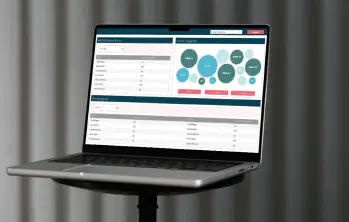Why an order book replay is an essential component of a holistic trade surveillance strategy
Financial firms are under greater regulatory scrutiny than ever before, with regulators placing a particular focus on their ability to provide transparent and accountable records of their trading activities. As manipulative trading activity grows in sophistication, many firms now face the need to investigate potentially suspicious behaviour that is no longer at the top of the order book.
To identify these risks and remain compliant, firms need a way to get a clear retrospective view of their trades, which is where an order book replay comes in.
What is an order book replay?
An order book replay is a visualisation of the order book that overlays client orders with market depth at each individual level (up to 10 levels deep) on the bid and the ask, providing a holistic view of their activity. It highlights how the market was both impacted and reacted to the placement/cancellation/execution of orders and is an aid for firms to investigate potentially manipulative trading activity that is, generally, not at the top of their order book.
The advantage of an order book replay is that it allows contextual information to be displayed in an easily digestible format that enables analysts to analyse, assess and then get to their risk quicker.
The benefits of an order book replay
Historically, firms have struggled with retrospective analysis of trading activity. One of the main reasons being that many have a limited retrospective view of their trading and order activity. For many, the data can be stored on disparate systems and consist of text-heavy data sets. So, when a regulator requires them to look further back in their order book, it’s often difficult and time consuming to collate the necessary information and analyse trades.
It’s also important to note that collating the data is just the first step. Analysing, interpreting and presenting the required data often requires specialist business intelligence tooling or expertise in data science - not something firms usually have in-house. This makes it a time consuming process that drains resources and slows down the firm’s ability to investigate risk.
eflow’s Order Book Explorer takes this functionality a step further by providing a suite of tools that make the investigation of past trades faster, more intuitive, and more insightful.
eflow’s Order Book Explorer: Beyond simple order book replay
As explored above, an order book replay is a powerful tool that enables firms to investigate past trades with more precision and in greater detail. eflow’s Order Book Explorer expands on this, enabling analysts to identify risks quicker by allowing them to, at a glance, view how orders impact depth of liquidity and best-bid-offers/spreads across traded assets. This is particularly relevant to regulations and market abuse scenarios that examine how orders (not just executions) affect price movements and executions.
The functionality facilitates the addition of visual evidence to case notes (via screen grabs or other data export options) and submissions to regulators. The creation of graphs over a timeline is more intuitive and provides more detailed contextual information on the impacts of orders, amendments, cancellations and executions than trade blotters or lists of events can do in isolation.
As part of eflow’s TZTS trade surveillance system, it offers a range of advanced features:
Highly visual order book snapshot - configure visual, graphical, trading activity reports that can be configured in line with analysts’ specifications for clearer analysis, interpretation and reporting. Visualise the impact on the input, execution or cancellation of orders on the order book lifecycle, whether examining Market Manipulation or Best Execution.
Price/volume timeframe replay - replay historical trading activity with live timeframe updates for orders, amendments, cancellations and executions (fill or partial fill). This allows firms to explore the order book in a more user-friendly, intuitive manner.
Playback controls - Explore the price/volume replay through play, pause, forward and rewind functionality, enabling quick access to the precise moment of interest.
Download for further analysis - extract key data, visualisations and reports, including all events that constitute the order book over a user-defined time period, for further analysis. This flexibility allows firms to incorporate order book insights into their broader risk management strategies.
Construct easily digestible reports - contextualised trading data reports can be generated without the need for specialist tools or expertise. Allowing users to present findings in a clear and easily digestible format, reducing the need for specialist tools or expertise.
In conclusion
Order book replay is becoming an indispensable tool for firms looking to maintain transparency, mitigate risks and meet regulatory requirements. With advanced features such as those available in eflow’s Order Book Explorer, analysts are able to reach evidence-based conclusions more quickly, without the need for specialist training or expertise in data manipulation or visualisation.
Enabling faster, more visual and comprehensive analysis of past trading activity, Order Book Explorer empowers firms to take control of their trading data, making sure they maintain the integrity of their trading operations, and stay ahead of regulatory requirements.
Book a no obligation consultation call with our team of experts who can walk you through a personalised demo of Order Book Explorer, and our other solutions, and offer advice on how best to overcome any regulatory challenges that your firm is facing.



